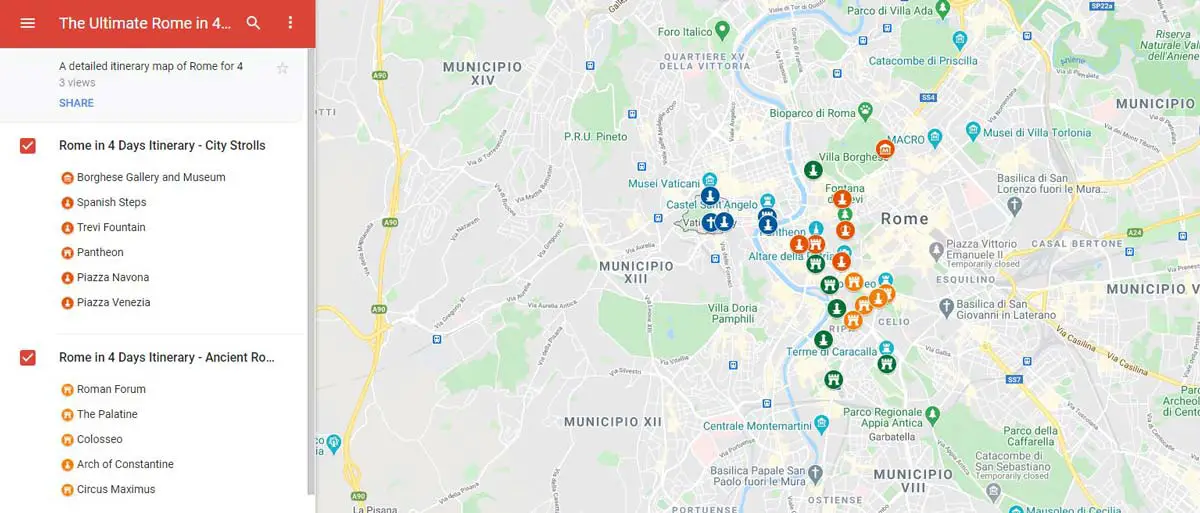The Ultimate Rome in 4 Days Itinerary
Last updated: 7 September 2020 | Guides, Italy
Table of Contents
Toggle
Rome in 4 days?! Yes, please!
The Eternal City is probably the most visited city in the entire world. That is no surprise, as Rome has so much to offer. Whether it be delicious Italian cuisine or ancient marvels, Rome has it all… in abundance!
Now, I am pretty sure that if it is your first time in Rome (or not) you are probably wondering what to visit, how much time would it take or how much would it cost? That is why I created this Rome in 4 days Itinerary, so that you can easily navigate through the city. I guarantee, that it will also save you lots of hassles!
Rome in 4 Days Itinerary Map
Things to Know Before You Go
Before heading to Rome, it is good to consider a couple of very important things:
✖ Avoid going to Rome before Easter or Christmas time – the city will be full with people. Speaking from personal experience, this is probably the worst time to visit the Eternal City and the lines are humongous.
✖ The best time of the week to visit Rome is from Tuesday through Friday. Most of the museum are closed on Monday and the weekend brings lots of tourists, thus you would like to avoid this.
✖ Buy tickets upfront to skip the lines. If you plan to visit the Colosseum buy a combined ticket, which includes the Roman Forum and the Palatine.
✖ Do not accept “gifts” from strangers. This is a scam and they will ask you to pay for it.
✖ Tourist tax is a thing! You pay a tourist tax per person per night and it depends mainly on the stars of your hotel. So, if your hotel is 2-3 stars you will pay 4 per night, or 6 euros if it is 4 stars and 7 euros if it is 5 stars.
✖ You pay for table service. The average “coperto” is 1.50 EUR per person or 10-20% of your bill and it depends on the restaurant. Always ask for the price of the table service if you want to avoid any misunderstandings.
✖ Tipping is not mandatory! You don’t have to give any tips, especially when there is a table service tax in every restaurant. However, if satisfied with the service, feel free to leave some 💰
Rome in 4 Days Itinerary - City Strolls
On the first day of your Rome in 4 Days Itinerary the focus will be more on getting familiar with the city. It is dedicated to sights that do not take much time to explore and are more laid back. Thus, you can explore the city without rushing from point to point.
The whole trip from Borghese Gallery to Piazza Venezia is around 5 km and takes half a day (5-6 hours) depending on your pace.

Galleria Borghese
By far one of the most visited galleries in Italy. Galleria Borghese is housing some of the finest masterpieces of Italy’s most talented artists. Among them are remarkable artists like Tiziano, Raphael, Caravaggio, Bernini and Botticelli.
Borghese gallery is housing Italy’s most incredible masterpieces and a huge collection of classic antiquities from the 1st to the 3rd AD. There you will witness some of the most well-preserved mosaics and ancient sculptures. Then, going up the gallery, you will find the collection with the works of Italy’s most prominent artists.
In addition to all that, there is a huge park surrounding the gallery. The park is full of monuments, museums and even a zoo to explore. Thus, you can spend quite a lot of time there wandering around.
EarthOSea Travel Tips:
🎟️ Price: 35 EUR
⌚️ Opening Hours:
Tuesday to Saturday: 9:00 AM – 7:00 PM.
🧐 Tip: Only few people are allowed to enter the gallery at a time. To have a chance to enter Borghese Museum Gallery, it is necessary to buy your ticket upfront.
Spanish Steps
After exploring the Borghese Gallery and Park head down to the Spanish steps. Probably one of the most crowded places to stop by in Rome.
The Spanish Steps are a well-known landmark and attract lots of tourists. Honestly, they are a perfect spot for a quick break on your city stroll!
You are probably wondering why they are called the Spanish Steps? The stairway was built to connect the Spanish Embassy and the Trinità dei Monti church. So, that is the reason for their name.
Below the Spanish step,at Piazza di Spagna, you will find the Spanish Steps fountain – Barcaccia. It’s a beautiful Baroque fountain shaped like a ship or as many would say “a wrecked boat”.

Trevi Fountain
Fontana di Trevi!
The most beautiful fountain in Rome… aaand in the whole world. The fountain is around 30 meters high and 50 meters wide, which makes it the largest Baroque fountain in Rome. After many years of hard work by Nicola Salvi, the Trevi fountain was finally finished in the 18th century by the architect Guiseppe Pannini.
The Trevi fountain is surely one of the symbols of the Eternal city. It is one of the most visited and always packed with people landmarks. That is no surprise, as there is a local legend that goes like that:
🤩 If you throw one coin, you will return to the Eternal city
😍 If you throw two coins, you will fall in love with an Italian
💍 If you throw three coins, you will marry this person
Don’t forget to throw the coins with your right hand over your left shoulder so that your wishes come true!
🤯 Fun Fact: In the past, the fountain was a meeting point of three streets. Therefore, its name Trevi comes from Tre Vie, which simply translates as “the three ways”.

The Pantheon
Closer to the Trevi fountain, you will find the Pantheon. Probably the oldest religious building in Rome. It was built around the 126 A.D. during the reign of Hadrian and served as an All Gods Temple. However, around the 7th century it was transformed into a catholic church.
The Roman Pantheon can easily be recognized by its round shape and its large size. Once you enter inside, you will be stunned by its dome. The world’s largest concrete dome! Yes, you read that right. This is the world’s largest concrete dome and it is 50 meters large. On top of that, there is a hole (oculus) in the middle of it that allows for natural light to illuminate the whole building! How cool is that?!
The Pantheon also serves as a resting place for most of the Italian kings. Even, one of Italy’s most famous Renaissance architects, Raphael has been buried here.
EarthOSea Travel Tips:
🎟️ Price: FREE
⌚️ Opening Hours:
Monday to Saturday: 8:30 am – 7:30 pm.
Sunday: 9:00 am – 6:00 pm
🤯 Fun Fact: There is an ancient Roman inscription at the main arch of the entrance that says “M.AGRIPPA.L.F.COS.TERTIVM.FECIT“. Translated to English it sounds like a glorification of Agrippa: “Marcus Agrippa, son of Lucius, built this temple when he was a Consul.”

Piazza Navona
Once a city market, Piazza Navona is now one of the most spectacular squares in Rome. With its Baroque Roman architecture it is attracting many tourists to its beautiful monuments.
The square is most famous with its fountains – the Fountain of four rivers, the Moor Fountain and the Fountain of Neptune.
The famous sculptor Bernini designed the Fountain of four rivers in the 16th century for Pope Innocent X, whose family’s palace face the famous square. On the other hand, Porta designed the The Moor Fountain. The fountain is famous for its rose-coloured marble basin and the statue of a Moor fighting with a dolphin surrounded by four Tritons. Porta also designed the Fountain of Neptune that represents the fight of Neptune with a giant octopus. It is on the other side of Piazza Navona.
I would recommend to visit the square at night, as the lights enhance the beauty of these masterpieces!
🤯 Fun Fact: During the 80 AD Domitian built a stadium on the exact place where Piazza Navona is today. The stadium of Domitian held many contests testing the wit and physical fitness of its contestants. Furthermore, it could seat around 30,000 people, which is quite impressive!

Piazza Venezia
Piazza Venezia, or the “Wedding Cake” as many know it, is one of the most famous modern buildings in Rome. It was built in the beginning of the 20th century as a tribute to the first Italian King – Victor Emmanuel II. Furthermore, it is a symbol of the unification of Italy and the power of Rome as a city.
Nowadays, Piazza Venezia is housing an art and military museum, and has one of the most beautiful panoramic views over Rome. If you want to go there, just to enjoy the view it is absolutely free. You just have to enter the monument and climb the stairs to the first floor. There you will wintess one of the best views over Rome!
EarthOSea Travel Tips:
🎟️ Price (for the top level terraces): 10 EUR/ 2 EUR (EU Citizens 18-25 years)
⌚️ Opening Hours:
Monday – Saturday: 10:00 AM – 6:00 PM
Closed on Sundays.
Rome in 4 Days Itinerary: Ancient Rome
Ancient Rome has always drawn the attention of many since its very beginning. That is no surprise, as it is simply remarkable!
On the second day of this Rome in 4 days Itinerary, the focus will be on the greatest ancient Roman marvels. These include the Roman Forum, the Palatine, the Colosseum, the Arch of Constantine and Circus Maximus.
It might take you around 7-8 hours to explore Ancient Rome and its marvels. So, pack yourself with lots of patience and energy!
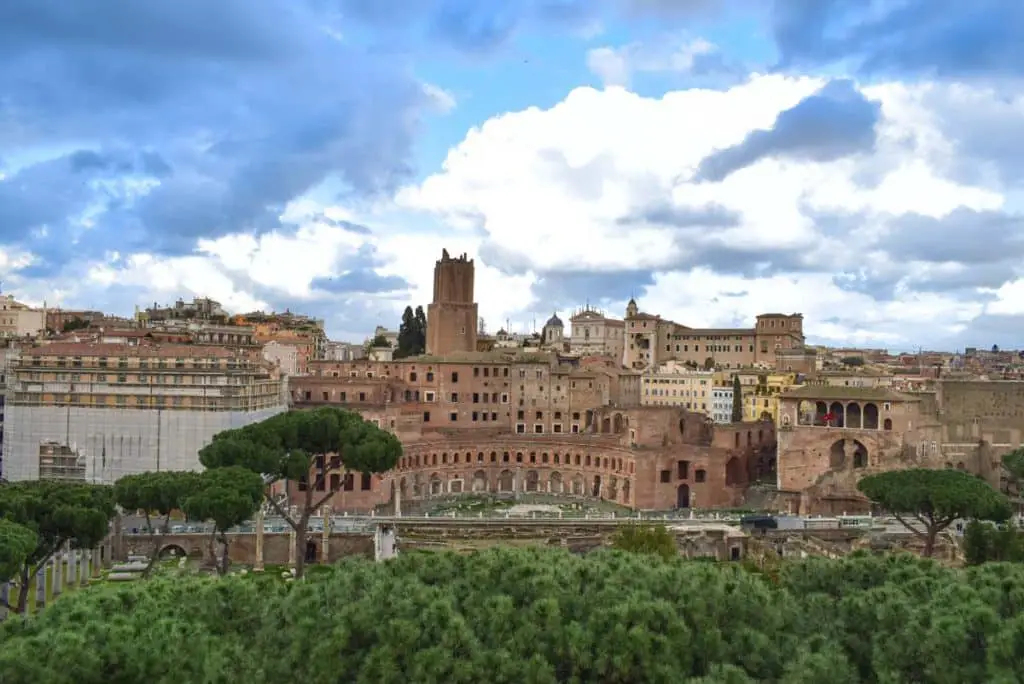
The Roman Forum
The Roman Forum was the heart of Rome. It was the place where the future of Rome was decided.
All of the political decisions were made in the Curia – the Senate’s building. In addition to that, the Roman Forum was a huge religious complex. It is housing many temples like that of Vesta, Venus and Saturn.
Back in the days, the citizens of Rome were gathering in the streets around the Roman Forum to socialize. That is due to the main street of ancient Rome – via Sacra being located there. And as the saying goes “All roads lead to Rome” we can easily conclude that “All roads lead to the Roman Forum”.

The Palatine
The Roman Orange County. Probably, you are asking yourself why I call it that way?
Back in the days, the rich Romans were building their palaces on that hill. Among them is Domus Flavia, the official residence of Emperor Domitian and the Hippodrome of Domitian, where he held horse races. Another palace that requires your attention is the House of Livia. Probably the most well-preserved house from the 1st century BC. It is famous for its frescoes and mosaics covering the walls and the ceilings.
The Palatine Hill is also the birthplace of Rome. As per the legend, the she-wolf that took care of the two brothers, Romulus and Remus, was living here. When the two brothers grew up they decided to build a city near the Tiber river. Unfortunately, they did not come to an agreement and Romulus killed Remus. And the rest is history.
🤯 Fun Fact: The Palatine Hill provides the best views over the Roman Forum. So, get your camera ready!

The Colosseum
The symbol of Rome. The Colosseum!
With its 2, 000 years of history, the Colosseum will bring you back in the time of Ancient Rome. Built during the rule of Titus in the 80 AD, it is the world’s most well-preserved ancient marvel. The Colosseum is almost 60 meters high and 200 meters large, which makes it bigger than most of the stadiums these days. Furthermore, it can accommodate up to 70, 000 people at a single show, which is quite a lot!
During the reign of the ancient Roman Empire, the Colosseum was the only source of entertainment in Rome. Some of the entertainment events included animal and gladiator battles, executions and recreation of famous battles. The Ancient Romans went to extremes when it came to entertaining themselves. They even flooded the Colosseum, so that they can recreate sea battles, which was recently found by archaeologists.
All of these shows continued for 5 centuries, until the Romans got very tired of them. After the 6th century, it seems as if people even forgot about the Colosseum and the ancient stadium lost its glory. Along with that, it became an object of numerous lootings, which led to destroying parts of the once glorious Colosseum.
EarthOSea Travel Tips:
🎟️ Price: 19.50 EUR (Includes entrances to Roman Forum & Palatine Hill)
⌚️ Opening Hours:
Everyday: 8:30 AM – 7:00 PM
🤯 Fun Fact: The Colosseum’s seatings are divided into a couple of sections. The Auditorium, the bottom seats, were preserved for the Emperor and the Senators. The Primum was above the Auditorium and was used by the knights. Then, the Imum and Summum, the seats above the Primum were used by the plebeians and citizens of Rome. In the Colosseum, there are even seats for the slaves – Ligneis, which are at the highest point of the stadium.

Arch of Constantine
Right behind the Colosseum is the Triumphal Arch of Constantine the Great. The triumphal arch is simply astonishing! The reason for building it was to celebrate the victory of Costantine over Maxentius. The Arch of Constantine consists of 2 smaller arches and 1 big arch and is 21 meters high (3 times smaller than the Colosseum).
It is fascinating that this arch is made entirely of marble and there are many statues that are taken from Trajan’s Forum. Furthermore, to add to this impressive arch, the Romans even carved various scenes depicting Marcus Aurelius feeding the poor. Finally, on the top of the arch they added an inscription glorifying Constantine that freed them from their tyrant and his followers. Impressive, right?!
Circus Maximus
Last on your stop for day 2 in Rome is Ciscus Maximus. The largest circus in whole Rome!
Although, there is not so much left of the once glorious circus, it is still quite fascinating. Circus Maximus is 600 meters large and 225 meters wide, which makes it the largest circus in Rome. It was so big that it could host 300,000 people!
Back in the days, the circuses in Rome were a place of entertainment, just like the amphitheaters and theaters. However, circuses entertained their public with lots of racing games – chariot, horse and foot races. To make everything even more spectacular, Romans were betting on the winners. This only made the games more competitive.
🤯 Fun Fact: Many of the competitors at Circus Maximus were slaves that were fighting for their freedom. The slaves were racing in small chariots against fellow slaves.
Rome in 4 Days Itinerary: The Vatican
It has been 2 days in Rome and it is time to go to a new country! Yes, you read that right. You are about to enter the world’s smallest country – the Vatican.
The Vatican won its freedom with the signing of the Lateran Treaty between Pope Pius XI and Mussolini in 1929. Ever since, the Vatican has been an independent state which was minting its own money, printing stamps and has its very own flag and anthem.
Although, the Vatican is a sovereign state it does not require any visa to visit it. There is no border or gate, thus you can freely walk in from Italy.

St. Peter's Basilica
Back in 1506 the old basilica, before St. Peter’s Basilica, was torn down and the construction of the new one began. Many notable architects were working on the design of the world’s holiest temples. Among them were Bramante, Michelangelo and Carlo Maderno.
Eventually, the basilica was finished in 1626 and was named after one of Jesus’s apostles – Saint Peter. Saint Peter’s Basilica is also the burial site of Saint Peter – the first Bishop of Rome.
Inside of the basilica there are incredible pieces of art. The Pietà by Michelangelo, the statue of Saint Peter, his baldachin and tomb under the high altar of the basilica.
The Dome
The Dome of Saint Peter’s basilica is quite fascinating. Entirely designed by Michelangelo and finished by Porta, it served as an inspiration for many cathedrals and religious buildings.
The entrance for the Dome of St. Peter’s basilica is on the right side of the basilica. After paying the admission fee you will be able to climb the 551 steps to get to the top, which is quite exhausting. However, you can always take the elevator and pass through the first 320 steps. Either way you will end up at a breathtaking view!
St. Peter's Square
During the 17th century, Bernini designed St. Peter’s square – the world’s most beautiful square! The square can house up to 300,000 people at a time and is the place where the Pope is holding his speeches. Thus, if you are in Rome on Sunday or Wednesday and want to see the Pope, head straight to Piazza San Pietro.
A very interesting part of St. Peter’s Square are its 284 columns and 88 pilasters holding the ceilings of the square! Above these columns there are 140 statues of saints seen from afar. And to top the greatness of this square, an Egyptian obelisk was put in the middle of it!
EarthOSea Travel Tips:
🎟️ Price: Basilica: FREE | Dome: 8 EUR/ 10 EUR (with elevator)
If you want to skip the line, you can buy your ticket here + Audioguide.
⌚️ Opening Hours:
October – March: 7:00 AM – 6:30 PM
April – September: 7:00 AM – 7:00 PM
🧐 Tip: Do not visit St. Peter’s Basilica on Wednesday or Sunday, as there are open masses. On days like that, the waiting time to enter the basilica can be indefinite.
🤯 Fun Fact: Saint Peter’s Basilica is built atop of a huge necropolis. In the 4th century A.D., Nero blamed the Christians for the fires in Rome and executed all of them on Vatican hill. Among these Christians was Saint Peter himself. After the recognition of the Christian religion in Rome by Constantine in the 4th century the new basilica was built on this place.

The Vatican Museums
The Vatican museums are the most famous and visited museums in the whole world. The museums were found in the 16th century when Pope Julius II purchased the first statue. It was the Laocoön and His Sons, which was found in a vineyard next to the basilica Santa Maria Maggiore. And the rest is history…
Nowadays, the Vatican Museums are housing 54 galleries full of masterpieces. There are also numerous rooms full of Roman artifacts going through different epochs. Furthermore, there are the papal residences, which are painted by Raphael. Probably at this point you will think to yourself “This can’t get any better”, until you see the Sistine Chapel. This is what I call an out of this world masterpiece!
The constriction of the Sistine Chapel began in 1473 and finished in 1481. However, it is not known for its architecture, but for its frescoes covering the walls and the ceiling.
Michelangelo worked 4 years on the 9 scenes from the Book of Genesis. Among these 9 scenes, the most famous is “The Creation of Adam”. Michelangelo also left his mark here with “The Final Judgement” representing the Apocalypse of St. John.
EarthOSea Travel Tips:
🎟️ Price: 17.00 EUR when purchased from the official website.
⌚️ Opening Hours:
Monday – Saturday: 9:00 AM – 6:00 PM
Closed on Sundays.
🧐 Tip: The entrance to the Vatican Museums is on the northeastern side of the Vatican. My advise is to be there early in the morning, so that you don’t wait a lot. Or simply book an evening trip to the Vatican museums, so that you avoid the crowds!
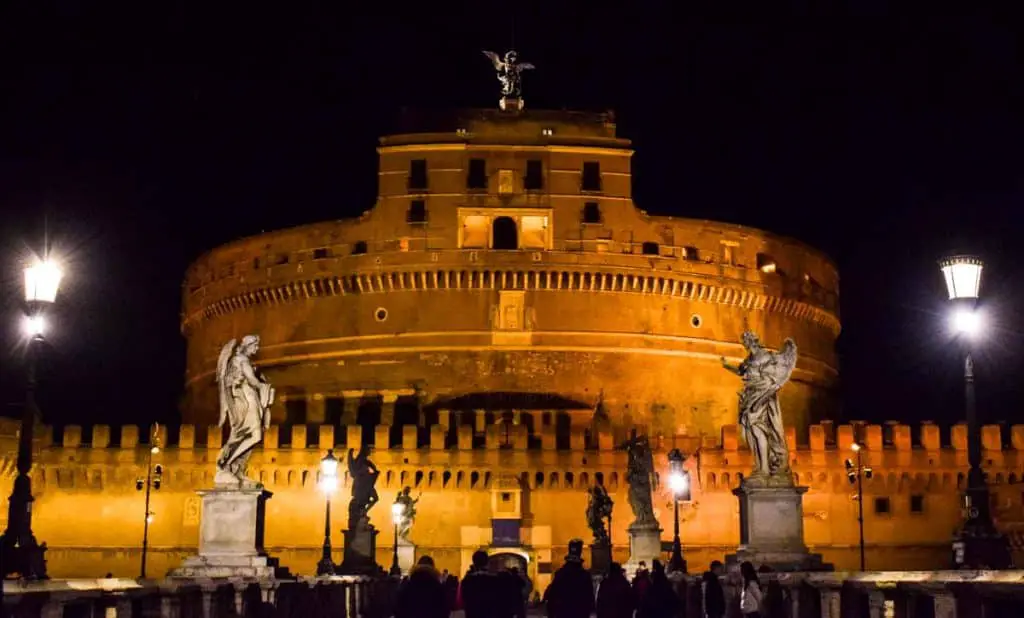
Castel Sant'Angelo
Just a couple of steps away from Piazza San Pietro is Castel Sant’Angelo. If you are a fan of Dan Brown or Assassin’s Creed you will love it!
Castel Sant’Angelo was built during the rule of Hadrian in 135. The main reason for building it was to use it as a mausoleum for the family of the Emperor. However, a couple of centuries later it was turned into a military fortress and later a safe house for the Popes.
It is very interesting to note that the castle has a secret corridor that connects it with the Vatican. During the 13th century the Pope ordered a secret corridor to be built, so that he can escape in case he is in danger.
Nowadays, the museum Castel Sant’Angelo is known for its collection of weapons. Along with that, there are many Papal rooms, various frescoes from the Renaissance period and a beautiful view over the St. Angelo bridge.
EarthOSea Travel Tips:
🎟️ Price: 15 EUR Adults | 7.50 (under 24 years for EU residents)
⌚️ Opening Hours:
Tuesday – Sunday: 9:00 AM – 7:30 PM
If you are a true Dan Brown fan and want to decode the riddles of Rome and visit the locations from Dan Brown’s “Angels and Demons” you should consider this trip!
Rome in 4 Days Itinerary: Hidden Gems
It has been three days in Rome and it is time to check the lesser-known places. On day 4 in Rome you can be as carefree as you want. Just relax and enjoy!
Piazza del Popolo
The first stop on day 4 in Rome is Piazza del Popolo or as it has been known since ancient time – People’s square.
Back in the days, Piazza del Popolo was one of the most important squares in the ancient world. It was the first place that all the foreigners were seeing when they entered Rome. It was also the square where many events were held including executions until the beginning of the 19th century.
Nowadays, Piazza del Popolo is one of the most fascinating squares in Rome. It can easily be distinguished by the rest with its Egyptian obelisk that sits in the middle of the piazza.
If you are a Caravaggio fan, you should definitely check his magnificent art pieces in the basilica of the square – Santa Maria del Popolo. They are simply incredible!
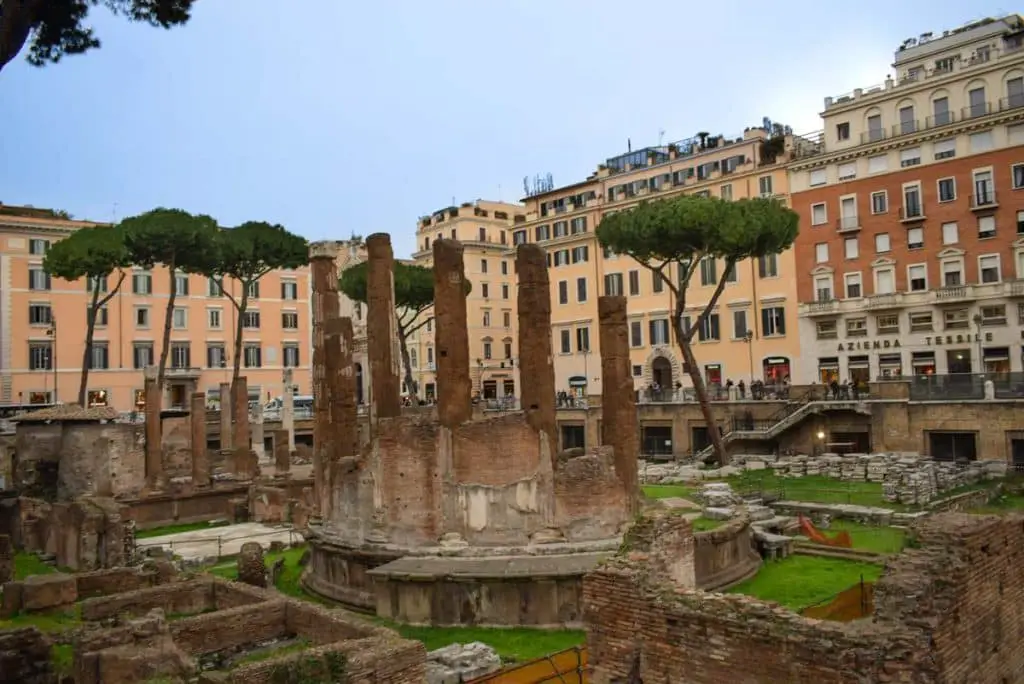
Largo di Torre Argentina
Just a couple of steps away from the Pantheon and Piazza Navona is the Largo di Torre Argentina. Or as many know it – the Cat’s Amphitheater.
In fact, back in 44 BC, Julius Caesar was walking for the last time in the temple of Pompey. He was stabbed to death by his own senators exactly in this place. Later, the place was turned into a complex with a couple of temples of little known gods and nymphs.
Nowadays, the temple complex is occupied by many furry meowing cuties strolling around the excavations. And this definitely makes the exploration a bit more entertaining 😻
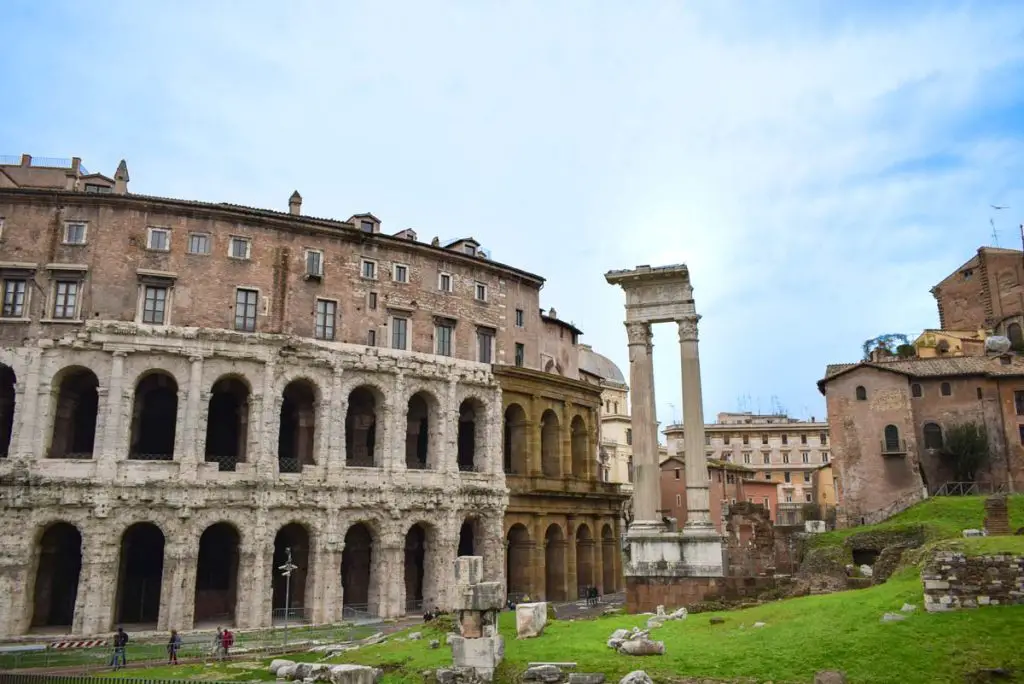
Marcello Theatre
Planned by Julius Ceaser in the 17 BC and finished in 12 BC by Augustus, Marcello theatre was Rome’s largest theatre. The theatre could fit more than 20, 000 spectators that came to enjoy drama performances and musicals.
Eventually, Marcello theatre became Rome’s most famous theatre and held one of the most fascinating drama performances. Unfortunately, in the beginning of the 4th century it slowly fell out of use, which led to its decay. Although, at some point it was restored by rich Italian families that used it as a fortress.
Nowadays, there are still many performances held in it during the summer months. The Roman Nights at Marcello’s Theatre are widely known among music lovers in the city.
The Mouth of Truth
Bocca della Verità! The prominent ancient lie detector responsible for the faith of many unfortunate Romans.
It is believed that the Mouth of Truth was used by the ancient Romans to find out if someone is lying. Many Romans were put to the test by getting their hand inside of the Mouth. If it bites, they were pronounced guilty, which led to unfortunate consequences for them.
Nowadays, the Mouth of Truth rests in front of Basilica di Santa Maria in Cosmedin at Piazza della Bocca della Verità. It is exactly opposite of the Fountain of the Tritons – a beautiful Renaissance fountain.
Piazza Dei Cavalieri Di Malta
Well, this is not the regular landmark in Rome. Actually, it is a sovereign territory of Malta, which housed a Benedictine monastery of the Templars.
The interesting part here is that there is a secret keyhole, through which you can see Saint Peter’s Basilica and the Vatican city. This view is different by all of the other views in Rome, as it holds the Roman Catholicism in itself surrounded by beautiful cypresses. Absolutely astonishing!
Next to the Piazza Dei Cavalieri Di Malta is the Giardino degli Aranci – Rome’s most scenic garden. Surrounded by orange trees and overlooking the Vatican city and Saint Peter’s Basilica, it is definitely a spot you should visit!
EarthOSea Travel Tips:
🧐 Tip: Visit the Piazza Dei Cavalieri di Malta at sunset so that you get a glimpse at Rome’s most romantic view! Keep in mind that the queue might be a long one, but the wait is worth it!
Baths of Caracalla
The Baths of Caracalla – Rome’s most spectacular ancient thermal complex!
Built by the order of Marcus Aurelius, known as Caracalla, the complex was a place for both social interactions and for maintaining good hygiene. It was surrounded by beautiful gardens, had a library, temples and a space for doing exercises. Sounds like an ancient heaven. I bet the Romans visiting it had the time of their lives!
Unfortunately, like anything else in Rome, the baths were abandoned after 3 hundred years when the barbarians destroyed their irrigation system. Later, an earthquake contributed to their destruction and decay.
However, today, there is still lots to see there. Parts of the buildings are still standing, along with the ground floors and the walls surrounding them. If you use your imagination, you can easily submerge yourself in the glorious times of the ancient Baths of Caracalla!
EarthOSea Travel Tips:
🎟️ Price: 8 EUR Adults| 4 EUR (EU citizens under 24 years old)
⌚️ Opening Hours:
Tuesday – Sunday: 9:00 AM – 7:30 PM
Monday: 9:00 AM – 2:00 PM
Pyramid of Cestius
At the end of the 4 days in Rome Itinerary I have put the Pyramid of Cestius. It is not such a well-known landmark in Rome and is often overlooked by tourists. However, it speaks a lot about the Egyptomania that gripped Rome during the conquest of Egypt in the 30 BC.
During these glorious times in the Roman Empire, lots of Egyptian artifacts were brought. Furthermore, the Roman architecture was also inspired by the Egyptian one. To date, there were only two pyramids built in Rome and one of them is the Pyramid of Cestius.
As per the inscription on the southeast side of the pyramid Cestius was a wealthy Roman magistrate. He ordered the construction of this pyramid in the 18 BC and it was led by his heirs and freedman. On the inside, the pyramid was decorated with frescoes depicting the life of the magistrate and resembled the pyramids in Egypt.
EarthOSea Travel Tips:
🧐 Tip: If you want to visit the Pyramid of Cestius you need to make a reservation upfront.
Where to stay in Rome?
Finding an accommodation in Rome can be a bit challenging, especially during the high season. However, it is not impossible and there are numerous of options. Whether you would prefer hotel, hostel or a private apartment, Rome has it all.
Rome is a city that can easily be explored by foot. Having this in mind, there is no need to stay in the city center of the city where all the crowds are. Instead, you can opt for neighborhoods such as San Saba, Trieste, Ostiense, Centocelle and Pigneto.
Below you can check for accommodation options I have prepared depending on your preferences:
If you are not a fan of hotels and hostels you can always opt for AirBnB.

Rome Experience
It’s one thing to explore Rome and it’s another to experience it. I have prepared some of the best experiences you can get in Rome:
Gladiator Show in Rome: Want to witness one of the greatest events in ancient Rome? If your answer is “yes”, check this spectacular show that recreates the fierce gladiator battles from the past.
Colosseum Arena Floor Tour:Exploring the Colosseum sounds amazing, but how about exploring its ground floor? The place where the gladiators were fighting with mighty exotic animals. Sounds trilling, right? It is even better when you get to skip the line!
Audience of Pope Francis:It is possible to witness the audience of Pope Francis every Wednesday in the Vatican city. However, it is good to do it with a local guide who will help you find a seat and tell you all the secrets the Vatican keeps!
Rome’s Ancient Villas Tour: Explore Rome’s most spectacular villas in the charming Tivoli! Less than an hour ride will take you to Hadrian’s ancient villa and Villa d’Este.
Ostia Antica Guided Tour with Local Archaeologist:Ostia Antica was the ancient port city of Rome, its main supplier and its defender. The ancient city is very well-preserved and there can be found various buildings that are still standing. I recommend this out of this world experience at Ostia Antica!
I hope that you have enjoyed these 4 days in Rome Itinerary. Did you visit any of the suggested landmarks?
Which one was your favourite?
